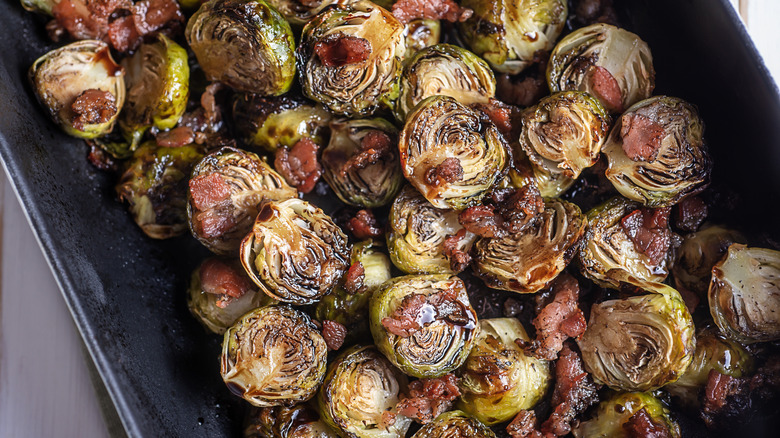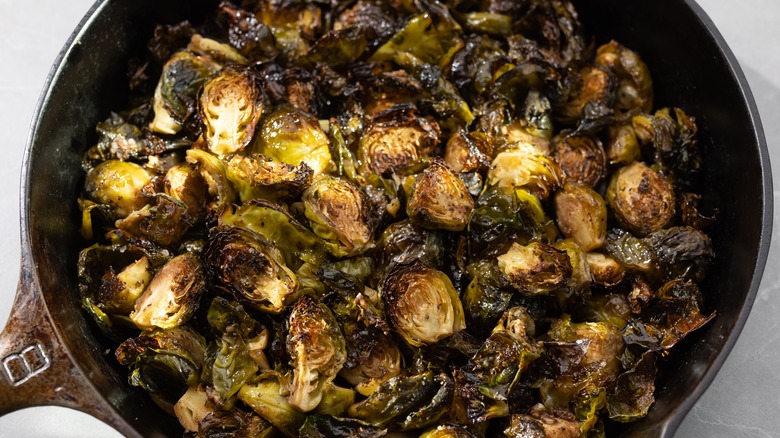The Best-Tasting Brussels Sprouts Start With A Mistake
Many of the world's greatest discoveries and inventions started as mistakes: X-rays, Velcro, penicillin, the microwave oven...the list goes on. And this couldn't be any truer for food. Potato chips, ice cream cones, chocolate chip cookies, and Champagne are all happy food accidents originally created by a blunder, error, or miscalculation. That's why you should never be afraid to take chances in the kitchen. Recipes can only take you so far, because, ultimately, each individual will have their own preferences, likes, and dislikes. What one person considers off-putting or unpleasant may actually be the next big food trend to take over social media.
And no ingredient embodies this polarization better than the Brussels sprout. When prepared improperly, these small cruciferous vegetables can be soggy, sad, and stinky. But when the right techniques and cooking methods are used, you can completely transform a bag of Brussels sprouts into a rich and complex appetizer, snack, or side dish. In this case, however, the "right" technique is doing things a bit, well, wrong. Burning your food is rarely a good idea and can often yield some unpleasant results, but when it comes to Brussels sprouts, this is couldn't be further from the truth. Giving your Brussels (and other vegetables) some extra char allows their natural sugars to caramelize, unlocking a whole new spectrum of tastes, flavors, and aromas. And it's pretty hard to screw up!
Why you should be burning your Brussels
Burning your Brussels sprouts is a simple technique that can take your roasted vegetable cookery to the next level. But what does it really mean to "burn" your vegetables? In this context, the term "burnt" simply refers to a serious degree of caramelization. Vegetables contain natural sugars and amino acids that change (and become more complex) when exposed to high temperatures. This is known as the Maillard reaction, and it is the same effect one gets when griddling a hamburger or steak over high heat. Not only does this hot-and-fast cooking style yield a crispy outer coating, but it also ensures that the middle of the vegetable is soft without being too mushy.
To achieve a perfectly charred platter of Brussels sprouts, the first mistake to avoid is cooking them at too low a temperature. Instead, roast them at a heat between 400 and 450 degrees Fahrenheit for around 25 minutes or, if using the stove top, cook them in a medium-hot skillet for ten minutes, before lowering the flame and continuing to cook until the insides are tender. Another pointer is to make sure that the Brussels sprouts are sliced in half (lengthwise) and spread in an even layer across the pan with the cut side down to ensure maximum contact with the cooking surface. Lastly, don't fiddle around with the Brussels sprouts as they roast; leaving them undisturbed allows them to develop that deliciously burnt crust.
Other vegetables that benefit from a good char
As mentioned above, burning or charring your vegetables unlocks an unexpected array of tastes, textures, and aromas. Spending some time in a hot oven or grill pan can turn ordinary ingredients into complex and exciting dishes. Brussels sprouts do particularly well under these conditions, but they are far from the only vegetable you can use. Asparagus, broccoli, bell peppers, corn, cabbage, carrots, sweet potatoes, cauliflower, zucchini, and even romaine lettuce can all benefit from being singed by the heat of the oven, frying pan, or grill.
However, not all of these vegetables require the same amount of cooking time or temperature. Thinner, more delicate ingredients, like asparagus or strips of zucchini, will darken faster, so don't let them get too crispy or they'll end up as a pile of ash. The same goes for romaine lettuce, which only needs a few minutes on a hot grill or pan to develop a charred flavor. Thicker roots and tubers, like carrots, sweet potatoes, and turnips, become even sweeter the longer they cook, with their outsides developing a burnt-sugar flavor akin to the crisp topping of a crème brûlée. And although a plate of burnt Brussels sprouts will never take the place of dessert, they will hopefully inspire you to make more delicious mistakes with your cooking.


